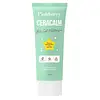What's inside
What's inside
 Key Ingredients
Key Ingredients

 Benefits
Benefits

 Concerns
Concerns

 Ingredients Side-by-side
Ingredients Side-by-side

Water
Skin ConditioningPanthenol
Skin ConditioningButylene Glycol
HumectantPropanediol
SolventGlycerin
HumectantPhenoxyethanol
PreservativeAmmonium Acryloyldimethyltaurate/Vp Copolymer
PEG-40
HumectantTetrasodium EDTA
Allantoin
Skin ConditioningCarbomer
Emulsion StabilisingEthylhexylglycerin
Skin ConditioningAminomethyl Propanol
BufferingVitis Vinifera Leaf Extract
Skin ConditioningPorphyridium Polysaccharide
AntioxidantCaprylic/Capric Triglyceride
MaskingDeoxyphytantriyl Palmitamide Mea
Skin ConditioningHydrogenated Lecithin
EmulsifyingCeramide NP
Skin ConditioningCholesterol
EmollientHamamelis Virginiana Extract
AntiseborrhoeicHydrolyzed Collagen
EmollientWater, Panthenol, Butylene Glycol, Propanediol, Glycerin, Phenoxyethanol, Ammonium Acryloyldimethyltaurate/Vp Copolymer, PEG-40, Tetrasodium EDTA, Allantoin, Carbomer, Ethylhexylglycerin, Aminomethyl Propanol, Vitis Vinifera Leaf Extract, Porphyridium Polysaccharide, Caprylic/Capric Triglyceride, Deoxyphytantriyl Palmitamide Mea, Hydrogenated Lecithin, Ceramide NP, Cholesterol, Hamamelis Virginiana Extract, Hydrolyzed Collagen
Water
Skin ConditioningButylene Glycol
HumectantBetaine
HumectantPEG/PPG-17/6 Copolymer
SolventAcrylates/C10-30 Alkyl Acrylate Crosspolymer
Emulsion StabilisingArginine
Masking1,2-Hexanediol
Skin ConditioningPPG-5-Ceteth-20
EmulsifyingArtemisia Vulgaris Extract
Skin ConditioningCentella Asiatica Leaf Extract
Skin ConditioningPropylene Glycol
HumectantPanthenol
Skin ConditioningPEG/PPG-14/7 Dimethyl Ether
Skin ConditioningAllantoin
Skin ConditioningPentylene Glycol
Skin ConditioningCaprylhydroxamic Acid
Dipotassium Glycyrrhizate
HumectantPhenoxyethanol
PreservativeEthylhexylglycerin
Skin ConditioningAvena Sativa Kernel Extract
AbrasiveSodium Hyaluronate
HumectantLavandula Angustifolia Oil
MaskingLactobacillus/Soymilk Ferment Filtrate
Skin ConditioningPortulaca Oleracea Extract
Skin ConditioningMelaleuca Alternifolia Leaf Oil
AntioxidantAloe Barbadensis Leaf Juice Powder
Skin ConditioningGlyceryl Caprylate
EmollientMentha Piperita Oil
MaskingBeta-Glucan
Skin ConditioningWater, Butylene Glycol, Betaine, PEG/PPG-17/6 Copolymer, Acrylates/C10-30 Alkyl Acrylate Crosspolymer, Arginine, 1,2-Hexanediol, PPG-5-Ceteth-20, Artemisia Vulgaris Extract, Centella Asiatica Leaf Extract, Propylene Glycol, Panthenol, PEG/PPG-14/7 Dimethyl Ether, Allantoin, Pentylene Glycol, Caprylhydroxamic Acid, Dipotassium Glycyrrhizate, Phenoxyethanol, Ethylhexylglycerin, Avena Sativa Kernel Extract, Sodium Hyaluronate, Lavandula Angustifolia Oil, Lactobacillus/Soymilk Ferment Filtrate, Portulaca Oleracea Extract, Melaleuca Alternifolia Leaf Oil, Aloe Barbadensis Leaf Juice Powder, Glyceryl Caprylate, Mentha Piperita Oil, Beta-Glucan
 Reviews
Reviews

Ingredients Explained
These ingredients are found in both products.
Ingredients higher up in an ingredient list are typically present in a larger amount.
Allantoin is a soothing ingredient known for its protective and moisturizingg properties. Because of this, it is often added to products with strong active ingredients.
Studies show higher concentrations of this ingredient can promote wound healing.
Though it can be derived from the comfrey plant, allantoin is produced synthetically for cosmetic products to ensure purity.
Learn more about AllantoinButylene Glycol (or BG) is used within cosmetic products for a few different reasons:
Overall, Butylene Glycol is a safe and well-rounded ingredient that works well with other ingredients.
Though this ingredient works well with most skin types, some people with sensitive skin may experience a reaction such as allergic rashes, closed comedones, or itchiness.
Learn more about Butylene GlycolEthylhexylglycerin (we can't pronounce this either) is commonly used as a preservative and skin softener. It is derived from glyceryl.
You might see Ethylhexylglycerin often paired with other preservatives such as phenoxyethanol. Ethylhexylglycerin has been found to increase the effectiveness of these other preservatives.
Panthenol is a common ingredient that helps hydrate and soothe the skin. It is found naturally in our skin and hair.
There are two forms of panthenol: D and L.
D-panthenol is also known as dexpanthenol. Most cosmetics use dexpanthenol or a mixture of D and L-panthenol.
Panthenol is famous due to its ability to go deeper into the skin's layers. Using this ingredient has numerous pros (and no cons):
Like hyaluronic acid, panthenol is a humectant. Humectants are able to bind and hold large amounts of water to keep skin hydrated.
This ingredient works well for wound healing. It works by increasing tissue in the wound and helps close open wounds.
Once oxidized, panthenol converts to pantothenic acid. Panthothenic acid is found in all living cells.
This ingredient is also referred to as pro-vitamin B5.
Learn more about PanthenolPhenoxyethanol is a preservative that has germicide, antimicrobial, and aromatic properties. Studies show that phenoxyethanol can prevent microbial growth. By itself, it has a scent that is similar to that of a rose.
It's often used in formulations along with Caprylyl Glycol to preserve the shelf life of products.
Water. It's the most common cosmetic ingredient of all. You'll usually see it at the top of ingredient lists, meaning that it makes up the largest part of the product.
So why is it so popular? Water most often acts as a solvent - this means that it helps dissolve other ingredients into the formulation.
You'll also recognize water as that liquid we all need to stay alive. If you see this, drink a glass of water. Stay hydrated!
Learn more about Water